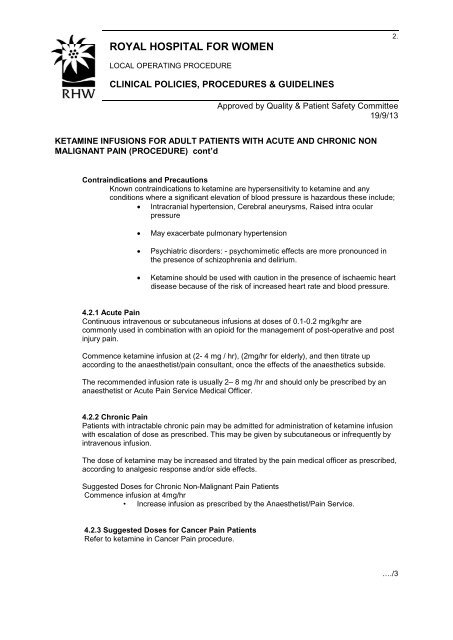Ketamine Infusions for Adult Patients with Acute and Chronic Non Malignant Pain
Ketamine Infusions for Adult Patients with Acute and Chronic Non Malignant Pain
Ketamine Infusions for Adult Patients with Acute and Chronic Non Malignant Pain
Create successful ePaper yourself
Turn your PDF publications into a flip-book with our unique Google optimized e-Paper software.
ROYAL HOSPITAL FOR WOMEN<br />
2.<br />
LOCAL OPERATING PROCEDURE<br />
CLINICAL POLICIES, PROCEDURES & GUIDELINES<br />
Approved by Quality & Patient Safety Committee<br />
19/9/13<br />
KETAMINE INFUSIONS FOR ADULT PATIENTS WITH ACUTE AND CHRONIC NON<br />
MALIGNANT PAIN (PROCEDURE) cont’d<br />
Contraindications <strong>and</strong> Precautions<br />
Known contraindications to ketamine are hypersensitivity to ketamine <strong>and</strong> any<br />
conditions where a significant elevation of blood pressure is hazardous these include;<br />
• Intracranial hypertension, Cerebral aneurysms, Raised intra ocular<br />
pressure<br />
• May exacerbate pulmonary hypertension<br />
• Psychiatric disorders: - psychomimetic effects are more pronounced in<br />
the presence of schizophrenia <strong>and</strong> delirium.<br />
• <strong>Ketamine</strong> should be used <strong>with</strong> caution in the presence of ischaemic heart<br />
disease because of the risk of increased heart rate <strong>and</strong> blood pressure.<br />
4.2.1 <strong>Acute</strong> <strong>Pain</strong><br />
Continuous intravenous or subcutaneous infusions at doses of 0.1-0.2 mg/kg/hr are<br />
commonly used in combination <strong>with</strong> an opioid <strong>for</strong> the management of post-operative <strong>and</strong> post<br />
injury pain.<br />
Commence ketamine infusion at (2- 4 mg / hr), (2mg/hr <strong>for</strong> elderly), <strong>and</strong> then titrate up<br />
according to the anaesthetist/pain consultant, once the effects of the anaesthetics subside.<br />
The recommended infusion rate is usually 2– 8 mg /hr <strong>and</strong> should only be prescribed by an<br />
anaesthetist or <strong>Acute</strong> <strong>Pain</strong> Service Medical Officer.<br />
4.2.2 <strong>Chronic</strong> <strong>Pain</strong><br />
<strong>Patients</strong> <strong>with</strong> intractable chronic pain may be admitted <strong>for</strong> administration of ketamine infusion<br />
<strong>with</strong> escalation of dose as prescribed. This may be given by subcutaneous or infrequently by<br />
intravenous infusion.<br />
The dose of ketamine may be increased <strong>and</strong> titrated by the pain medical officer as prescribed,<br />
according to analgesic response <strong>and</strong>/or side effects.<br />
Suggested Doses <strong>for</strong> <strong>Chronic</strong> <strong>Non</strong>-<strong>Malignant</strong> <strong>Pain</strong> <strong>Patients</strong><br />
Commence infusion at 4mg/hr<br />
• Increase infusion as prescribed by the Anaesthetist/<strong>Pain</strong> Service.<br />
4.2.3 Suggested Doses <strong>for</strong> Cancer <strong>Pain</strong> <strong>Patients</strong><br />
Refer to ketamine in Cancer <strong>Pain</strong> procedure.<br />
…./3


